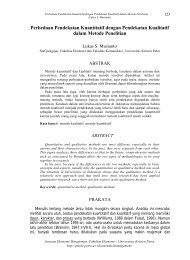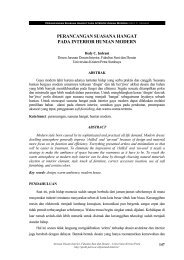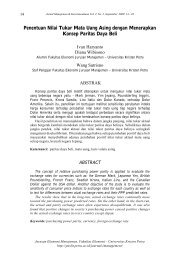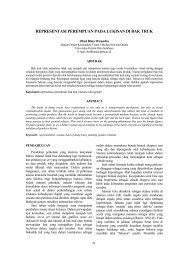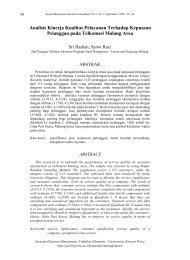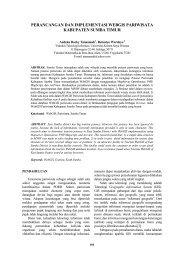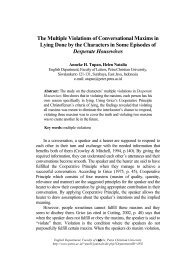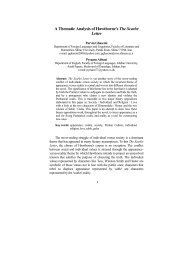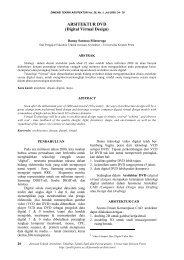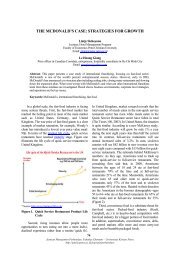Remote Fuzzy Logic Control System For a DC Motor Speed Control
Remote Fuzzy Logic Control System For a DC Motor Speed Control
Remote Fuzzy Logic Control System For a DC Motor Speed Control
Create successful ePaper yourself
Turn your PDF publications into a flip-book with our unique Google optimized e-Paper software.
8<br />
Jurnal Teknik Elektro Vol. 2, No. 1, Maret 2002: 8 - 12<br />
<strong>Remote</strong> <strong>Fuzzy</strong> <strong>Logic</strong> <strong>Control</strong> <strong>System</strong> <strong>For</strong> a <strong>DC</strong> <strong>Motor</strong> <strong>Speed</strong> <strong>Control</strong><br />
Thiang, Andru Hendra Wijaya<br />
Electrical Engineering Department, Faculty of Industrial Technology, Petra Christian University<br />
email: thiang@petra.ac.id<br />
Abstrak<br />
Makalah ini akan membahas tentang sistem kontrol kecepatan motor <strong>DC</strong> jarak jauh berbasis kontrol fuzzy logic<br />
yang diimplementasikan dengan menggunakan sistem operasi Linux. Sistem kontrol fuzzy logic ini dapat<br />
didesain dan dikontrol dari komputer mana saja yang menggunakan jaringan TCP/IP dan protokol http.<br />
Kecepatan motor <strong>DC</strong> dikontrol antara 800-2400 RPM. Program dibuat dengan bantuan bahasa C dan Perl.<br />
Beberapa pengujian telah dilakukan antara lain kecepatan proses kontrol fuzzy logic pada berbagai tipe dan<br />
kondisi server dan pengujian sistem kontrol kecepatan motor <strong>DC</strong> dengan berbagai variasi setting point. Hasil<br />
pengujian menunjukkan bahwa kecepatan kontrol fuzzy logic kernel adalah 5,8 milidetik pada komputer server<br />
AMD K6-2 400 MHz dengan memori 224 MB dan 16,8 milidetik pada komputer server Pentium 120 MHz<br />
dengan memori 32 MB. Sistem ini juga telah diuji dengan dijalankan dari komputer lokal dan komputer remote<br />
pada setting point 800 RPM, 1600 RPM dan 2400 RPM selama 90 detik dan sistem dapat berjalan dengan baik<br />
dalam mengontrol kecepatan motor <strong>DC</strong>. Waktu sampling yang diperlukan untuk beban komputer server yang<br />
ringan adalah 0,8929 detik/proses dan untuk beban komputer server yang berat 0,9646 detik/proses.<br />
Kata Kunci: <strong>Fuzzy</strong>, fuzzy logic, kontrol, linux, internet<br />
Abstract<br />
This paper will discuss about <strong>DC</strong> motor speed control based on fuzzy logic control system implemented on<br />
Linux operating system. This fuzzy logic control system can be designed and controlled from remote area i.e.<br />
any personal computer, which use TCP/IP network and http protocol. Range of <strong>DC</strong> motor speed which is<br />
controlled is 800-2400 RPM. Software is designed by using C language and Perl.<br />
Experiments were done for testing speed of fuzzy logic control process in any server type and condition, and also<br />
the experiments were done for testing the <strong>DC</strong> motor speed control system in various setting point. The results<br />
show that speeds of fuzzy logic control for AMD K6-2 400 MHz server with 224 MB memory and Pentium 120<br />
MHz with 32 MB memory are 5.8 ms and 16.8 ms respectively. This system had been tested from local<br />
computer and remote computer at setting point 800 RPM, 1600 RPM and 2400 RPM for 90 seconds and system<br />
can control speed of <strong>DC</strong> motor well. The server computer which has light processes, takes 0.8929 second<br />
sampling time and server computer which has heavy processes takes 0.9646 second sampling time.<br />
Keywords : remote fuzzy, fuzzy logic, control, linux, internet.<br />
Introduction<br />
Nowadays, fuzzy logic control is one of the<br />
hottest topics in the control field. <strong>Fuzzy</strong> logic<br />
control is a digital control methodology that<br />
allows the human description of the physical<br />
system and of the required control strategy to be<br />
simulated in a reasonably natural way. A fuzzy<br />
logic controller can be regarded as a real-time<br />
expert system that employs fuzzy logic to<br />
manipulate qualitative variables.<br />
Unfortunately, most of fuzzy logic control that<br />
has been made is implemented on the same loca-<br />
Catatan: Diskusi untuk makalah ini diterima sebelum tanggal 1 Mei<br />
2002. Diskusi yang layak muat akan diterbitkan pada Jurnal Teknik<br />
Elektro volume 2, nomor 2, September 2002.<br />
tion with the plant and it can’t be controlled or<br />
designed from remote area. This paper will<br />
discuss about remote fuzzy logic control system<br />
run on Linux operating system. The system can<br />
be designed and controlled from anywhere PC<br />
using TCP/IP network and http protocol. Linux<br />
operating system is installed on site computer<br />
(the computer that connected to the plant).<br />
Membership function for inputs, membership<br />
function for outputs and knowledge base can be<br />
designed or redesigned from remote or on site<br />
computer using http browser software. <strong>Fuzzy</strong><br />
logic control also can be activated or deactivated<br />
from remote or on site computer using http<br />
browser. This remote fuzzy logic control system<br />
will be implemented to control a plant that is a<br />
<strong>DC</strong> motor. It will be implemented to control a<br />
Jurusan Teknik Elektro, Fakultas Teknologi Industri – Universitas Kristen Petra<br />
http://puslit.petra.ac.id/journals/electrical/
<strong>Remote</strong> <strong>Fuzzy</strong> <strong>Logic</strong> <strong>Control</strong> <strong>System</strong> <strong>For</strong> a <strong>DC</strong> <strong>Motor</strong> <strong>Speed</strong> <strong>Control</strong><br />
[Thiang, et al.]<br />
<strong>DC</strong> motor speed at any desired speed between<br />
800-2400 RPM.<br />
<strong>Fuzzy</strong> <strong>Logic</strong> <strong>Control</strong> <strong>System</strong><br />
<strong>Fuzzy</strong> logic control is a control algorithm based<br />
on a linguistic control strategy, which is derived<br />
from expert knowledge into an automatic control<br />
strategy. <strong>Fuzzy</strong> logic control doesn't need any<br />
difficult mathematical calculation like the others<br />
control system. While the others control system<br />
use difficult mathematical calculation to provide<br />
a model of the controlled plant, it only uses<br />
simple mathematical calculation to simulate the<br />
expert knowledge. Although it doesn't need any<br />
difficult mathematical calculation, but it can give<br />
good performance in a control system. Thus, it<br />
can be one of the best available answers today<br />
for a broad class of challenging controls<br />
problems. A fuzzy logic control usually consists<br />
of the following [1]:<br />
1. A fuzzyfication unit. This process converts or<br />
transforms the measured inputs called crisp<br />
values, into the fuzzy linguistic values used<br />
by the fuzzy reasoning mechanism.<br />
2. A knowledge base. A collection of the expert<br />
control rules (knowledge) needed to achieve<br />
the control goal.<br />
3. A fuzzy reasoning mechanism. This process<br />
will perform fuzzy logic operations and result<br />
the control action according to the fuzzy<br />
inputs.<br />
4. A defuzzyfication unit. This process converts<br />
the result of fuzzy reasoning mechanism into<br />
the required crisp value.<br />
The most important things in fuzzy logic control<br />
system design are the process design of<br />
membership function for inputs, outputs and the<br />
process design of fuzzy if-then rule knowledge<br />
base. They are very important in fuzzy logic<br />
control.<br />
<strong>System</strong> Design<br />
Block diagram of remote fuzzy logic control<br />
system can be seen at figure 1.<br />
The meaning of remote fuzzy logic control<br />
system is this system can be designed in remote<br />
computer by using http browser. Membership<br />
function and rule knowledge base can be<br />
designed in remote computer that is connected to<br />
server (On site computer) via TCP/IP network<br />
and http protocol.<br />
Figure 1. Block Diagram of <strong>Remote</strong> <strong>Fuzzy</strong> <strong>Logic</strong><br />
<strong>Control</strong> <strong>System</strong><br />
Figure 2. Infrared Sensor Circuit<br />
Computer server is connected to a <strong>DC</strong> motor<br />
plant. It consists of <strong>DC</strong> motor, sensing circuit,<br />
89C51 minimum system, and <strong>DC</strong> motor driver.<br />
The sensing circuit is designed by using infrared<br />
diodes. Transmitter part is connected to the VCC<br />
by using a 220Ω resistor and receiver part is<br />
operated in reverse mode and connected to the<br />
VCC by using a 10kΩ resistor. The detailed<br />
circuit connection can be seen at figure 2.<br />
<strong>DC</strong> motor driver circuit uses one IC L293D. This<br />
IC is a push-pull driver specially designed for<br />
driving <strong>DC</strong> motor power. The detailed circuit<br />
connection can be seen at figure 3.<br />
Jurusan Teknik Elektro, Fakultas Teknologi Industri – Universitas Kristen Petra<br />
http://puslit.petra.ac.id/journals/electrical/<br />
9
10<br />
Figure 3. <strong>Motor</strong> Driver Circuit<br />
The 89C51 minimum system is needed to<br />
produce pulse width modulation signal (PWM)<br />
that will be used by <strong>DC</strong> motor driver circuit to<br />
drive <strong>DC</strong> motor power. It also calculates the<br />
speed of <strong>DC</strong> motor by counting the electrical<br />
pulse generated by sensing circuit.<br />
Communication between 89C51 minimum<br />
system and computer server is done via parallel<br />
port (LPT1).<br />
Figure 4. Minimum <strong>System</strong> Circuit<br />
The 89C51 minimum system will set input signal<br />
of motor driver or send <strong>DC</strong> motor speed to server<br />
according to command from server.<br />
Jurnal Teknik Elektro Vol. 2, No. 1, Maret 2002: 8 - 12<br />
Some programs are designed for implementing<br />
fuzzy logic controller on Linux Operating<br />
<strong>System</strong>. They are:<br />
• Tafuzz1. This program will do the fuzzy<br />
logic control process. Thus, it is called fuzzy<br />
logic kernel. This program will be run by<br />
demo1.cgi program. This program is designed<br />
by using C language.<br />
• Fuzzdesign.cgi. This program is used for<br />
designing, redesigning and testing input<br />
membership function, output membership<br />
functions and rules of fuzzy logic control<br />
system. This program is design by using Perl<br />
language.<br />
• Test. This program will be run by sub<br />
program of fuzzdesign.cgi for testing input<br />
membership functions, output membership<br />
functions and rules of fuzzy logic control.<br />
This program is designed by using C<br />
language.<br />
• Stop. This program is used for resetting the<br />
parallel port register after the computer<br />
finished booting process. This program is<br />
designed by using C language.<br />
• Cekport. This program is used for testing the<br />
parallel port to find out whether the parallel<br />
port can run in EPP mode correctly. This<br />
program is designed by using C language.<br />
• Demo1.cgi. This program will run tafuzz1<br />
from website, create graphic of motor speed,<br />
see or delete log.pl file, and see or delete<br />
graphic of motor speed. This program is<br />
designed by using Perl language.<br />
• Demo2.cgi. This program displays the last 15<br />
seconds motor speed log. This program is<br />
designed by using Perl language.<br />
• Demo3.cgi. This program displays the last<br />
second motor speed log. The other function of<br />
this program is to display current setting point<br />
and control status at server. This program is<br />
designed by using Perl language.<br />
<strong>Motor</strong> <strong>Speed</strong> <strong>Control</strong> Application<br />
The system was implemented on <strong>DC</strong> motor<br />
speed control application. In this application,<br />
fuzzy logic control system has two inputs and<br />
one output. The inputs of fuzzy logic control are<br />
Error and Derror. The output of fuzzy logic<br />
control is change of speed. Error is defined by<br />
the difference between setting point and present<br />
value and Derror is defined by the difference<br />
between present error signal and previous error<br />
Jurusan Teknik Elektro, Fakultas Teknologi Industri – Universitas Kristen Petra<br />
http://puslit.petra.ac.id/journals/electrical/
<strong>Remote</strong> <strong>Fuzzy</strong> <strong>Logic</strong> <strong>Control</strong> <strong>System</strong> <strong>For</strong> a <strong>DC</strong> <strong>Motor</strong> <strong>Speed</strong> <strong>Control</strong><br />
[Thiang, et al.]<br />
signal. The following equation was used to<br />
calculate the error signal and derror signal.<br />
Error = SP − PV<br />
(1)<br />
Derror = Error n − Error n − 1 (2)<br />
( ) ( )<br />
where SP is setting point, PV is present value,<br />
Error(n) is present error, and Error(n-1) is<br />
previous error.<br />
Membership function of error and derror has 5<br />
labels i.e. negative big (nb), negative small (ns),<br />
zero (z), positive small (ps), and positive big<br />
(pb). Membership function of output speed<br />
change has 9 labels i.e. negative3 (n3), negative2<br />
(n2), negative1 (n1), negative0 (n0), zero (z),<br />
positive0 (p0), positive1 (p1), positive2 (p2),<br />
positive3 (p3). There are 25 fuzzy if-then rules<br />
used in this system. <strong>Fuzzy</strong> if-then rules were<br />
extracted from an expert knowledge. Table 1<br />
shows the fuzzy if-then rules database used in<br />
this system. Figure 5, and 6 show input<br />
membership function and figure 7 shows output<br />
membership function. Output membership<br />
function used fuzzy singleton type. This will<br />
make easier in calculating process.<br />
Derror<br />
Table 1. <strong>Fuzzy</strong> If-Then Rules Database<br />
nb Ns<br />
Error<br />
Z ps pb<br />
nb n3 n3 n0 Z p3<br />
ns n3 n2 n0 p0 p3<br />
z n3 n1 Z p1 p3<br />
ps n3 n0 p0 p2 p3<br />
pb n3 Z p0 p3 p3<br />
Figure 5. Error Input Membership Function<br />
Figure 6. Derror Input Membership Function<br />
Figure 7. <strong>Speed</strong> Output Membership Function<br />
Experiment result<br />
Some experiments were done by testing speed of<br />
fuzzy logic control process, testing system<br />
response of <strong>DC</strong> motor speed control and testing<br />
remote fuzzy logic control system.<br />
The system has been tested to prove that it can<br />
work well. <strong>Fuzzy</strong> logic control system like<br />
membership function and fuzzy if-then rules was<br />
designed from the remote computer. IP address<br />
of the remote computer is 202.43.252.54 and IP<br />
address of server is 202.43.252.60. Experiment<br />
result show that the system can run well.<br />
Some experiments were also done to test the<br />
speed of fuzzy logic control process that runs on<br />
linux operating system. Figure 8 and 9 shows the<br />
experiment result for testing speed of fuzzy logic<br />
control process in two types server. The<br />
experiment result shows that average speed of<br />
fuzzy logic control process varies from 5 ms to<br />
16 ms and it depends on the type of computer.<br />
Jurusan Teknik Elektro, Fakultas Teknologi Industri – Universitas Kristen Petra<br />
http://puslit.petra.ac.id/journals/electrical/<br />
Time (second)<br />
0.015<br />
0.01<br />
0.005<br />
0<br />
1 2 3 4 5 6 7 8 9 10<br />
Number of Experiment<br />
Figure 8. <strong>Speed</strong> of <strong>Fuzzy</strong> <strong>Logic</strong> <strong>Control</strong> Using<br />
AMD K6-2 400 MHz 224 MB RAM<br />
Time (second)<br />
0.035<br />
0.03<br />
0.025<br />
0.02<br />
0.015<br />
0.01<br />
0.005<br />
0<br />
1 2 3 4 5 6 7 8 9 10<br />
Number of Experiment<br />
Figure 9. <strong>Speed</strong> of <strong>Fuzzy</strong> <strong>Logic</strong> <strong>Control</strong> Using<br />
Pentium 120 MHz, 32 MB RAM<br />
<strong>For</strong> testing system response of <strong>DC</strong> motor speed<br />
control, some experiments were also done by<br />
testing the system at various setting point i.e. 800<br />
11
RPM, 1600 RPM, and 2400 RPM. Figure 10<br />
shows control system response at setting point<br />
800 rpm. Figure 11 shows control system<br />
response at setting point 1600 rpm and figure 12<br />
shows control system response at setting point<br />
2400 rpm.<br />
Figure 10. Graph of <strong>Control</strong> <strong>System</strong> Response At<br />
Setting Point 800 rpm<br />
The graphs show that fuzzy logic control system<br />
can control speed of <strong>DC</strong> motor and keep <strong>DC</strong><br />
motor speed at defined setting point.<br />
Figure 11. Graph of <strong>Control</strong> <strong>System</strong> Response At<br />
Setting Point 1600 rpm<br />
Figure 12. Graph of <strong>Control</strong> <strong>System</strong> Response At<br />
Setting Point 2400 rpm<br />
The experiment was also done for testing<br />
performance of the system when server has light<br />
12<br />
Jurnal Teknik Elektro Vol. 2, No. 1, Maret 2002: 8 - 12<br />
processes or heavy processes. The result shows<br />
that the system can handle all processes well.<br />
Conclusion<br />
Starting from the experiment and experience, it<br />
can be concluded that implementation of fuzzy<br />
logic for remote control system based on Linux<br />
operating system has been performed well. The<br />
system can work well although network traffic is<br />
busy because all program are located at server<br />
computer. Experiment results show that the<br />
system can control speed of <strong>DC</strong> motor well. But,<br />
the system could not achieve a real time remote<br />
system because the system could not control the<br />
network traffic. <strong>For</strong> further development, system<br />
security must be implemented in order to prevent<br />
unauthorized people use the system.<br />
Reference<br />
[1]. Yan, J., Ryan, M., and Power, J., Using<br />
<strong>Fuzzy</strong> <strong>Logic</strong>, Englewood Cliffs, New<br />
Jersey: Prentice-Hall, Inc., 1994.<br />
[2]. Parker, Tim, Linux Unleashed, Third<br />
Edition., Macmillan Computer Publishing,<br />
1994.<br />
[3]. Parker, Tim, Teach Yourself TCP/IP in 14<br />
Days, Second Edition., Indianapolis: Sams<br />
Publishing, 1996.<br />
[4]. Purbo, Onno W., Apache Web Server,<br />
Jakarta: PT Elex Media Komputindo, 2000.<br />
[5]. Push-Pull Four Channel Driver, SGS-<br />
Thomson Electronic.<br />
[6]. Schwartz, Randal L., Learning Perl,<br />
Sebastopol, CA: O’Reilly & Associates,<br />
Inc., 1993.<br />
[7]. Stewart, Zhahai. IBM Parallel Port FAQ/<br />
Tutorial, [http://home.rmi.net/~hisys/<br />
parport. html]. 1996.<br />
Jurusan Teknik Elektro, Fakultas Teknologi Industri – Universitas Kristen Petra<br />
http://puslit.petra.ac.id/journals/electrical/





